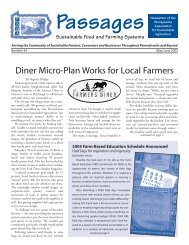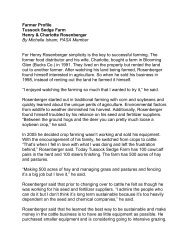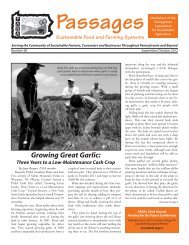Passages Sustainable Food and Farming Systems - PASA
Passages Sustainable Food and Farming Systems - PASA
Passages Sustainable Food and Farming Systems - PASA
You also want an ePaper? Increase the reach of your titles
YUMPU automatically turns print PDFs into web optimized ePapers that Google loves.
A <strong>PASA</strong> member since 2005, Jeff Biddle’s milking<br />
herd includes a variety of breeds, among them<br />
Ayrshires, Jerseys, Guernseys <strong>and</strong> Holsteins.<br />
By Sylvia P. Onusic, PhD,<br />
<strong>PASA</strong> Member<br />
It is near milking time at Bear Meadows<br />
Farm near Boalsburg just under the<br />
Tussey Mountain in Central PA, not far<br />
from the Penn State Campus. The cows<br />
are coming down from the pasture to the<br />
paddock outside the parlor, occasionally<br />
bellowing a long moo, which says its<br />
milking time. I st<strong>and</strong> outside with the<br />
owner of the place <strong>and</strong> tell him that the<br />
cows look beautiful, <strong>and</strong> that I especially<br />
like the white one. Farm owner, Jeff Biddle<br />
says, “Yeah, it’s all pasture, <strong>and</strong> that’s<br />
Elsie May, an old girl.” In fact, he knows<br />
each cow by name, as well as their personality<br />
<strong>and</strong> habits. Nearby three farm<br />
cats are lined up closely together in silhouette,<br />
along with Jeff’s two guinea<br />
hens, anticipating that something good is<br />
about to happen.<br />
Until 1948, farm fresh milk (raw<br />
milk) <strong>and</strong> pasteurized milk coexisted<br />
<strong>PASA</strong> Member Finds<br />
Success <strong>and</strong> Happiness in<br />
Grass <strong>Farming</strong> <strong>and</strong> Raw Milk<br />
Production:<br />
The Story of Jeff Biddle<br />
legally. But in 1948 a federal m<strong>and</strong>atory<br />
pasteurization law ended national access<br />
to fresh milk. Now it is up to the individual<br />
states to determine if fresh milk is<br />
legal. In Pennsylvania we are fortunate to<br />
be able to purchase raw milk at the farmgate<br />
<strong>and</strong> in specific shops. In Virginia<br />
purchase of raw milk by consumers is illegal<br />
unless you own part of the cow, as in<br />
“cow-shares.” In several other states, raw<br />
milk is sold as “pet food.” The website<br />
realmilk.com lists the status of raw milk<br />
in the fifty states.<br />
According to the Federal government,<br />
there are about 15 million raw milk<br />
drinkers in the U.S. <strong>and</strong> the number continues<br />
to grow. When people are asked<br />
why they drink raw milk, the majority<br />
proclaim, ‘the taste.’ And Jeff’s milk is<br />
long <strong>and</strong> creamy, its distinctive taste<br />
determined ultimately by the soil <strong>and</strong><br />
what is growing in it, something that the<br />
French call terroir. The plants <strong>and</strong> grasses<br />
growing on Jeff’s fields <strong>and</strong> nourishing<br />
his animals are the products of this terroir,<br />
which ultimately translate into tasty<br />
milk.<br />
Another major contributor to the taste<br />
of raw milk is the amount of butterfat it<br />
contains. Cow breeds vary in the amount<br />
of butterfat in their milk with Jerseys<br />
being high fat producers. Jeff’s herd is a<br />
variety of breeds, among them Ayrshires,<br />
Jerseys, Guernseys <strong>and</strong> Holsteins, which<br />
contribute to the ultimate taste of the<br />
milk product in the bulk milk tank.<br />
Among his herd are four Holsteins,<br />
which he adopted from industrial dairies.<br />
He says that they are good milkers.<br />
The types <strong>and</strong> number of bacteria it<br />
contains also influences the taste of the<br />
milk.<br />
We know that bacteria can be friendly<br />
<strong>and</strong> good for digestive health, as well as<br />
useful, helping us prepare fermented<br />
dairy products like yogurt <strong>and</strong> kiefer<br />
(probiotic) or unfriendly (pathogenic)<br />
which can make us ill. Pasteurization<br />
destroys some pathogens but more so the<br />
friendly probiotic lactobacillus bacteria,<br />
enzymes <strong>and</strong> healthful substances which<br />
raw milk contains, like lactase, the<br />
enzyme which enables digestion of the<br />
lactose in milk. Pasteurization renders the<br />
lactase inoperable. But because the raw<br />
milk still contains its lactase, many people<br />
who are lactose intolerant <strong>and</strong> cannot<br />
drink pasteurized milk, can drink raw<br />
milk, says raw milk safety expert, Ted<br />
Beals, MD.<br />
Jeff’s milk is the only raw milk that I<br />
buy in the area, which I could successfully<br />
“clabber” or sour. Clabbering was<br />
done in my gr<strong>and</strong>ma’s day by putting a<br />
covered container of raw milk in a warm<br />
place, such as on the back of a counter or<br />
in a cupboard, for a few days depending<br />
on the time of year <strong>and</strong> temperature of<br />
the room, then used for drinking, cooking<br />
<strong>and</strong> baking. Clabbered or sour milk is<br />
a popular traditional beverage in Eastern<br />
<strong>and</strong> Central European, as well as Middle<br />
Eastern countries, especially during summer<br />
months. It has a refreshing smooth<br />
rich taste with an acid finish.<br />
Sour is not the same as spoil. Pasteur-<br />
continued on page 20<br />
19







